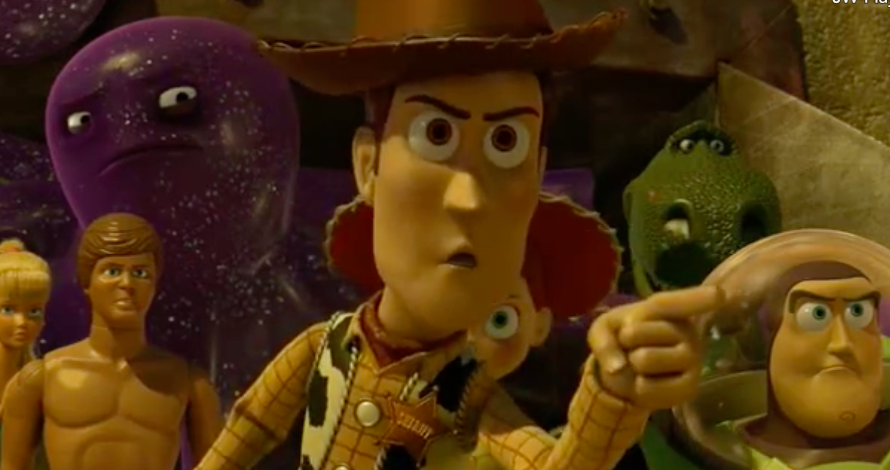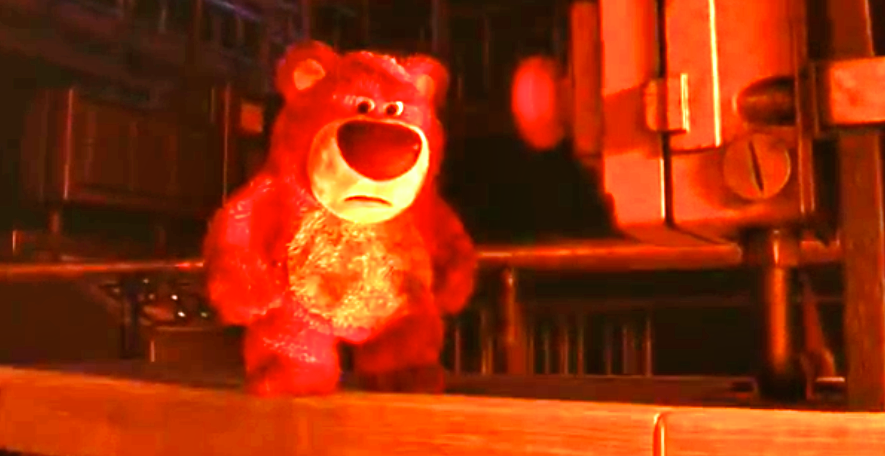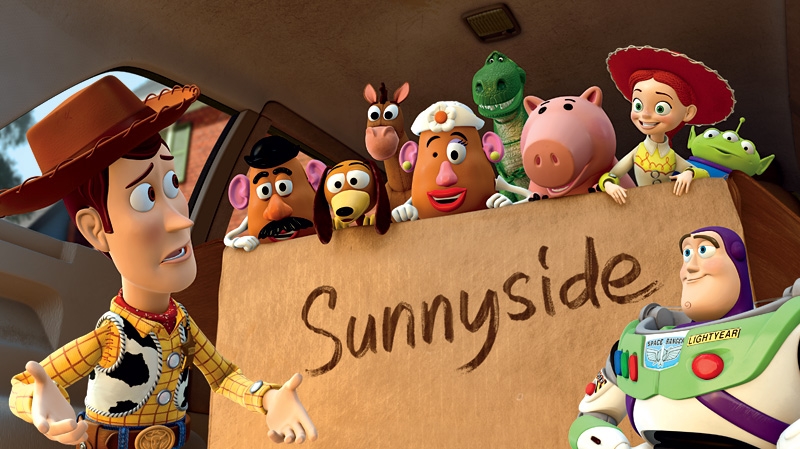“We must learn to regard people less in the light of what they do or omit to do, and more in the light of what they suffer.”
– Dietrich Bonhoeffer, Letters and Papers from Prison
I remember stepping out into the hot desert heat from the Red Rock Resort Hotel and Casino in Las Vegas on the afternoon of June 23, 2010 after having watched Toy Story 3 – but it wasn’t necessarily the heat that struck me. No, it was something else – something about the movie that left a bit of a bitter taste in my mouth that I couldn’t quite put my finger on. While I enjoyed it, as many others in attendance did, I couldn’t help but feel something was, well…off. Upon watching it a second time, I had a better understanding why I felt the way I did and putting it into context – a huge summer family film – left me scratching my head as to what the folks at Pixar were actually thinking with some of their story choices.
My concern stemmed from the film’s misuse of empathy, choosing to take a tone centered on vengeance or “comeuppance” that is perhaps a reflection of our society in general – but hardly the qualities and attributes one might expect from a spectacle like the Toy Story Trilogy that is catered toward children more so than adults. As discussed in the previous article, that a film such as The Woodsman was able to take an unsympathetic character in Walter – a recently released child molester who’s just served twelve years in prison – and allow for him a measure of forgiveness and redemption begs the question: why couldn’t Pixar do the same for a strawberry-scented teddy bear?
The problem begins with the awkwardly-conceived revelation of Lotso’s backstory. I say awkward because its function in the story is not very clear considering the outcome. What it does, however, is provide a perspective of how Lotso became the iron-paw ruler of Sunnyside he is today. Its immediate function is to alert Woody to the problems his friends face at Sunnyside since he assumed he left them in good hands. When the toys divulge Sunnyside to be a place of despair, Woody asks them “how do you know that?” – but rather than giving them firsthand accounts of their own experiences, they turn to Chuckles the clown to recant Lotso’s sad story:
Woody could have easily discerned the trouble his friends were in had the other toys recanted their own personal tales – but Pixar opted to include a two-and-a-half minute flashback to give both Woody and the audience Lotso’s backstory, creating – at least for the audience – a sense empathy. Do we like what Lotso has become? No, but we have an understanding of why he became the way he is via the emotions expressed – but the filmmakers were just teasing us with any hope of Lotso’s redemption, making the backstory’s inclusion a somewhat frustrating experience. Empathy, after all, is an agent for change – allowing us to see another’s perspective and understand it, sometimes to the point it makes us feel compassion toward them despite the things they’ve done.
When Woody has a chance to confront Lotso, he merely recants the story told to him, vehemently noting that Daisy only replaced Lotso and not the others. What’s striking about this is the fact that here was an opportunity for Woody to empathize with Lotso and try to influence him to change, for Woody himself knows what it feels like to be “replaced” – that was essentially what the original Toy Story was about with the introduction of Buzz Lightyear. In this sense, Woody’s dealt with the same sense of jealously as Lotso towards new toys (and toys in general), just not to the same degree – which would have made him a perfect mentor for facilitating change.
Furthermore, Lotso represents the negative arc of what happens when one can’t let go and move on (a theme that plays throughout the film with both toys and humans, Andy the cornerstone of each.) Having been forgotten on a picnic, Lotso eventually finds he’s been replaced and lets jealously twist his heart, making life for any “new toy” as miserable as he possibly can. Rather than make an any attempt to be “re-discovered” by Daisy, Lotso leaves – projecting his abandonment onto Daisy when he later says sheabandoned him.
For Woody, this has thematic relevance because he’s refusing to let go of Andy and argues his point that the toys should be there for him despite the fact that Andy himself has grown older and will be moving on to another phase of his life. Such a dichotomy should have made Woody more empathetic toward Lotso’s plight, especially considering the similar predicament he’s faced with himself: will he be able to let go of Andy and move on himself?

There were all sorts of angles to be explored here contrasting Woody/Lotso, but the interesting narrative choices continued down a unredeemable path. Once the toys are thrown together and face their imminent doom, Woody does the expected and lends a hand to Lotso, saving him. Lotso, in turn, seems grateful, yet humbled with his “thank you, sheriff” – finally the bear with a heart that seemed worthy of being saved that was hinted at in his backstory prior to being lost.
This continues into the next story beat as Lotso notices the button that needs to be pushed that could save them all. The focus of the scene, Lotso courageously makes his way upstream, yelling “Sheriff! The button – help me!” Getting the needed boost from Woody and Buzz, the filmmakers let Lotso reach the top – inches from earning redemption and becoming a hero – only to have him turn vile again. And for what? Prolonging the toys’ collective sense of doom, only to have a deus ex machina moment with a claw?

Like most villains in any given movie, the filmmakers gave Lotso his “just desserts” as he found himself picked up by a garbageman and strapped to the front of the truck, horrified with the thought of his open mouth catching flies. While the resolution to Lotso’s story thread provided for a humorous story beat, it’s quickly forgotten as the central story’s more heartfelt resolution unfolds with Woody et al saying goodbye to Andy. This ending, regardless of whatever happened to Lotso, was immensely satisfying – to the degree it’s what made most people leaving the theater feeling the way they did…even if there was a slight bitter aftertaste in Losto’s some people’s mouth.

In an article written in Psychology Today, Vengeance in Disneyland?, David Lunberg Kenrick noted:
A recent study by Mario Gollwitzer and Markus Denzler compared two theories of what makes revenge bitter or sweet: According to the “comparative suffering” hypothesis, we will feel better if the person who hurts us has something bad befall him, even if we had no hand in it. According to the “understanding” hypothesis, we will feel better if our offender signals that he understands why he was being smitten. Using a measure of implicit goal satisfaction, they found that people felt better only if their offender understood the reason for his punishment. This research suggests that, if a movie-maker wants to make revenge feel good for the audience, the perpetrator should express understanding. That didn’t happen in Toy Story 3.
David Lunderg, “Vengeance In Disneyland?” – Psychology Today
David Lunberg Kenrick’s point puts the focus of empathy onto Lotso’s shoulders, which could very well have enabled Lotso to express regret – but even so, that understanding could have been facilitated by Woody. As is, the back and forth of perspectives between the two is never resolved and leads nowhere other than a false sense of hope: Lotso appears to be humbled and change, only to cling to his perspective that toys aren’t meant to be loved. He never truly sees beyond the walls he’s erected as defense mechanisms to keep himself from ever being hurt again and believing it’s the way it ought to be for every toy. In that sense, he shares the same ideology of “sticking together” as Woody, but his methodology, the way he chooses to go about fulfilling this is drastically different.
Kenrick goes further to explain:
There’s of course, another alternative to the revenge route. It’s going the way of positive psychology– and forgiving your offender. University of Miami psychologist Mike McCullough reviews evidence that people who forgive are more agreeable and emotionally stable than the unforgiving. McCullough also reports that we’re more likely to forgive another if we feel empathy, if we make generous attributions about our offender, and if we don’t ruminate on how he or she done us wrong.
Reading this passage alone, one would almost think he was talking about the scene in The Woodsmanbetween Walter and Robin, an R-rated movie with strong sexual content vs. G-rated family fantasy. This is ultimately the power of empathy as an agent for change – something that should be weighed with a critical eye when using in a story with regards to audience reception. Having Woody as that vessel for empathy and change would have tied the series together in a more meaningful way had he reminded the toys that, at one time, felt anger towards him as well because of his jealousy of Buzz in the original Toy Story.

As Kenrick concludes, what we want in a kid’s movie is positive psychology – especially considering the power of story and narrative to influence behaviors. That the filmmakers went the “vengeance” route speaks perhaps as a reflection of our society in general; we’re very much “an eye for an eye” in terms of retribution, always seeking some form of retribution against the unjust. It would be a shame if the filmmakers fashioned their outcome for Lotso based on test screenings, catering to an expectation of this kind of comeuppance rather than something more positive that facilitates healing and growth. After all, as writers, we know that what a character wants is very rarely what it actually needs…and the same could often be said of audiences, too.
Written By: James P. Barker



Bravo, man. You hit the nail on the head and through the wall. This week has been outstanding, hats off. This’ll come in handy later on. What are the coming attractions?
LikeLike
Thanks! Not sure yet – I’ll kick around an idea or two tomorrow unless somebody else has one to offer up!
LikeLike
Exactly. This is why I hated this movie. I don’t know how you’re still able to praise it. Horrid. Brought me down. Left me empty.
Well put, sir.
LikeLike
I liken movies to people: they’re rarely perfect and try to appreciate them for what they are, warts and all, as there’s usually some redeeming qualities within. 🙂 But yes, it’s hard to overlook in this case (and perhaps harder not to dwell on, which prompted me to write about it.)
LikeLike
Wow, that just explained why the movie felt so wrong!
LikeLike
“Getting the needed boost from Woody and Buzz, the filmmakers let Lotso reach the top – inches from earning redemption and becoming a hero – only to have him turn vile again. And for what? Prolonging the toys’ collective sense of doom, only to have a deus ex machina moment with a claw?”
You make it seem as if that deus ex machina moment wasn’t immensely satisfying in the context of a movie made to entertain. In that sense, having the movie go down the path of redemption for Lotso would’ve eliminated the harrowing moments in the incinerator where the toys accept their fate and look to each other for final comfort, drawing upon the history of their bonds built up over the trilogy, which for me was an incredibly powerful scene. It may also have changed the eventual ending with Andy, another powerfully moving scene.
I’m sympathetic to Lotso’s fate (to a point), even to where I’d maybe accept slight changes to his story, but as a movie, I don’t think redeeming Lotso to hero status would’ve allowed Toy Story 3 those two powerfully moving ending scenes that involved the main elements of the series: the toys’ relationships to Andy and the toys’ relationships to each other. If it’s one or the other, I’ll take the latter. I think the empathy for Lotso was adequately displayed when Woody went to save him; if having Lotso go vile was the cost to allow the rest of the movie to ratchet up it’s intensity, I’m fine with that choice.
LikeLike
Lotso doesn’t need to be successful in order to have redemption; he could very well have made an effort, failed, and left the characters in the very same predicament.
The question is: why would the author/filmmakers give the character a compelling backstory that makes an audience empathize with him, only to have the rug pulled out from underneath them?
Audiences feel the empathy characters have toward one another, and yes, Woody makes an attempt, but ultimately all that happens on the screen has to be understood – at least on a subconscious level – by the audience. Here, again, they’re asked to empathize and invest themselves emotionally into a character setting up an expectation of redemption, but it doesn’t happen. Instead, they get regression which left some people asking what the point was.
A better handling of the story would have been for Woody to have a self-revelation upon his attempting to help Lotso understand that he needs to let go. It would have fit perfectly into the theme of the story and forced Woody to realize where his own personal issues reside.
Such a point would not have changed the ending of the story at all – it would have made it more organic having Woody realizing first-hand the negative impacts of holding on to something that’s no longer there.
Lastly, you’ll be hard pressed to find many story analysts and editors who condone the use of deus ex machinas. Even Spielberg has taken a certain amount of grief over their use in some of his films as they ultimately void any meaning within a story’s structure.
That wasn’t necessarily the case with Toy Story 3 because the moment didn’t occur at the story’s climax – it was just the climax of that particular sequence. The real climax is when Woody is forced to make his decision with Andy.
LikeLike
Honestly, very good character analysis of Lotso. 10/10
LikeLike